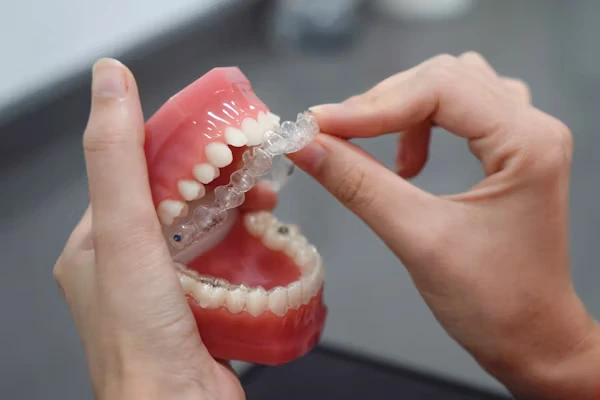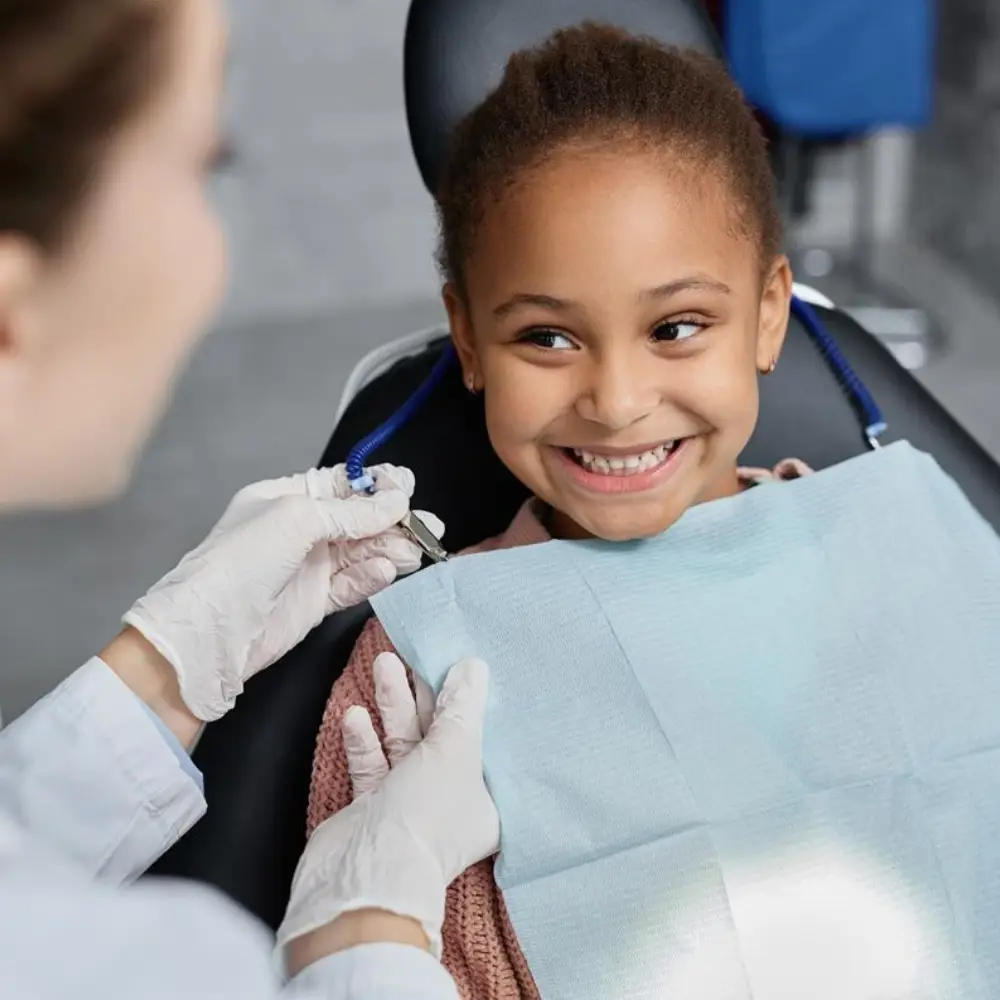Invisalign helps the public speakers to smile and address the audience with confidence- without the interference of the braces which are metal. It does not matter whether you are chairing a meeting, delivering a keynote, or hosting a podcast, your look and your articulation count. Conventional braces may influence the quality of speech and attract undesired attention. Invisalign aligners are comfortable and almost invisible, so you can concentrate on what you are saying, rather than your mouth. It is the ideal option of the professionals who desire to enhance their smile without spoiling their presence.
Why Invisalign Is Ideal for Professionals Who Speak Frequently
Invisalign is a great option when it comes to professionals whose profession requires them to communicate with confidence. Whether it is a keynote speaker, a teacher, a politician, an influencer, and a sales professional, it is non-negotiable to be articulate and confident in front of a crowd. Invisalign is the only thing that is different in this group of people because it does not only look good, but it functions.
Unlike conventional braces, clear aligners are almost unnoticeable and much less prone to disturbing speech when used on a regular basis. The comfort, convenience and discretion of invisalign enable speakers to be on stage without being distracted by metal brackets or wires. When your livelihood is based on speaking, or you speak regularly, you will require orthodontic care that improves your skill of communicating with other people, not one that interferes with it.
Clear Aligners vs. Braces for On-Stage Presence
Orthodontic treatment is not a favorite choice of public speakers since they believe that it interferes with their public image and the clarity of their speech. Conventional braces are a distraction in the workplace, especially during presentations and interviews- not to mention the possibility of food being stuck or discomfort when having to deal with long engagements.
On the contrary, Invisalign clear braces are unnoticeable. They are detachable, allowing you to remove them temporarily when you need to make a big presentation or performance. They are also designed to be smooth and fit customly to reduce irritation, particularly to people who speak hours on end. Although braces have the ability to change the movement of lips or cause bulky feelings, Invisalign remains discreet and does not affect your facial expressions or enunciation. This is the difference to anyone in the spotlight to how you are seen, and how you feel.
How Invisalign Improves Confidence During Presentations
Confidence does not only rest on appearance, but it is how a person feels in their body. When you are insecure about the crooked teeth or you fear that your braces are distracting your audience, this fear can influence your delivery.
Invisalign helps to build confidence in various ways which are particularly useful to a public speaker. It has a discreet look that enables you to smile normally without attracting attention to your orthodontic work. The aligners are smooth and comfortable, which means that they will not irritate you as sharp wires or brackets do. They are removable and this gives you control of when and where to wear them and it is easy to prepare ahead of the important speaking engagements. The trays are designed to give you predictable results that are visible and this keeps you motivated during the process.
Once you feel confident about the way you smile, you are free to concentrate on what you are saying, and not on the way you are saying it.
How Invisalign Affects Speech During Treatment

Invisalign is a discreet way of getting straighter teeth and many first-time users have questions about how it will change their speech. Because the aligners are tightened over your teeth, you might have to take some time to adjust to it, so you may find that you pronounce some words a little differently, especially words with an s or sh sound. The positive thing is that, the majority of the people adjust easily and any lisp or alteration in speaking normally lasts a few days. As you wear the braces and practice regularly, your speech will come back to normal and your smile will be improving steadily.
Initial Adjustment Period and What to Expect
You should not be surprised to find that your speech has a slight change in the initial days of undergoing Invisalign treatment. The majority of the users report a slight lisp or differences in the pronunciation of the letters s and sh. This tends to go away as your tongue gets used to the presence of the aligners. It has a short learning curve. Your mouth adapts fast with daily use and practice. This adjustment can be speeded up by reading aloud or practicing speeches.
Techniques to Reduce Lisping or Slurring
In order to reduce early speech problems with Invisalign, experiment with some easy to follow tips. Talk slowly and clearly, so that your tongue can get used to the aligners. Train the pronunciation of the problematic sounds such as s and th since they are most likely to be impacted. Daily reading aloud of 10 to 15 minutes can help a great deal to enhance clarity and accelerate the adaptation process. You should also keep your mouth moist- dryness will only increase the chances of slurring. It is a matter of time with regular practice and patience most of the people will find their speech back to normal in the first week.
When and How to Remove Aligners Before Speaking Engagements
Among the most outstanding advantages of Invisalign is that it is removable allowing public speakers the leeway in times of high stakes such as TV appearances, podcasts recording, or live events. When you have to remove your aligners you should always keep them in your case to avoid losing them or breaking them. Preferably, avoid spending more than 2 hours a day out of them as it may slow down your treatment process. You should brush and rinse before reinserting so that your aligners, and your mouth, are clean. All you have to remember: Invisalign will give the best results when used 20-22 hours per day.
Maintenance and Convenience for Busy Speakers

Invisalign is convenient, and therefore it suits busy people and individuals who communicate in front of a crowd. Its no-fuss care regimen can be easily incorporated into busy lifestyles: there is no necessity to have long dental visits or to go to the emergency room because of a broken wire. It is easy to clean, and one can take it off to eat and clean easily. The Invisalign is a discrete and efficient method of keeping your smile without interfering with the lifestyle of those who are always on the move.
Cleaning Your Aligners While Traveling or On Tour
The fast-paced lifestyle requires things to be easy, and Invisalign is just that. You have to clean your aligners, whether you are travelling and catching flights or getting ready to perform back-to-back speaking engagements, but you do not need to maintain a complex routine. The only thing you need is a compact cleaning kit (with aligner crystals or tablets), lukewarm water (to rinse), and a travel-sized toothbrush with unscented soap. These tiny, regular routines help you maintain your aligners fresh, transparent, and ready to be presented anywhere due to life circumstances.
Best Times to Wear Aligners for Maximum Results
For public speakers with inconsistent schedules, timing aligner wear around less demanding periods helps maximize both comfort and effectiveness.
Some tips:
- Wear aligners while sleeping and during commuting or desk work.
- Remove during meals and big speaking events.
- Don’t skip wearing them overnight—this is when much of the alignment happens.
With strategic planning, aligners can fit seamlessly into your daily rhythm.
Aligners and Mic Use: Comfort in Extended Wear
The mic is uncomfortable to wear on a long-term basis, and metal braces make it even more uncomfortable. Invisalign aligners are smooth and tight, and therefore one can hardly feel them during a long speaking performance. They will not be caught on lavalier microphones, will not make your gum sore, or dry your lips. And because they are made to fit your mouth, they do not move or click as you speak. With long-term presentations or events taking a daytime, Invisalign provides a long time comfort that would be incomparable with conventional braces.
Choosing Invisalign Providers with Speaker Experience
As a public speaker, it is beneficial to find an Invisalign provider who has a grasp of the special requirements of your occupation. Find dentists or orthodontists that have experience in working with performers, broadcasters or professionals that are very dependent on speech. Such providers will be more likely to foresee the issues related to clarity of speech, appearance, and flexibility of the schedule. Find out what their experience was like, their timeframes of treatment, and support at critical moments. The right provider will not only straighten your teeth but will also make you camera-ready and confident on your way.
Providers Who Understand Performance-Based Needs
Not every orthodontist is knowledgeable about the special requirements of the people who heavily depend on speech as their work. As a public speaker, singer or on-camera personality, you should select a provider with experience in treating the likes of you. Such experts are more inclined to schedule aligner treatments around performances, provide advice on how to reduce the impact on their speech, and customize treatment, both aesthetically and comfortably. During research, review, seek referrals with peers and during the consultation clarify what you are committed to speaking. By selecting the correct provider, your Invisalign experience will not be a detriment to your voice but a facilitator.
Invisalign Near Me: How to Find Speaker-Friendly Clinics
To locate providers of Invisalign who have worked with speakers and performers, begin with searching online with the terms such as Invisalign near me, Invisalign for professionals, or the official provider locator at the Invisalign site. Get recommendations from other speakers, actors, or people working in the media who you trust. Pay attention to patient reviews, in particular, those that contain the word comfort, speech, or discretion of treatment. By doing some research in advance, one can avoid unwanted frustration and have a less stressful, more supportive experience with treatment.
Frequently Asked Questions (FAQs)
1. Will Invisalign affect my ability to speak clearly on stage?
You may notice a slight lisp or subtle change in speech during the first few days of wearing Invisalign. This is completely normal and usually caused by your tongue adjusting to the aligners. Fortunately, most people adapt quickly as their mouth becomes more familiar with the trays. Practicing speaking out loud especially words with “s” and “th” sounds can help speed up the adjustment. Reading aloud, slowing your pace, and staying hydrated are also helpful strategies. With regular wear, speech clarity typically returns to normal within a week.
2. Can I remove my aligners for important presentations?
Yes, Invisalign is removable, which is a major advantage for public speakers and performers. You can take the aligners out briefly for high-stakes events like presentations, recordings, or live appearances. This flexibility allows you to communicate with full confidence when it matters most. Just be mindful not to exceed the recommended limit of 2 hours per day without them. Consistent wear, 20 to 22 hours daily, is essential to keep your treatment on track and your results predictable.
3. How long before I feel comfortable speaking with Invisalign?
Most users feel confident speaking within 5 to 7 days of wearing their first set of Invisalign aligners. While some may notice a slight change in pronunciation at first, this typically fades as the tongue and mouth adjust. Regular speaking practice like reading aloud, reciting speeches, or rehearsing presentations can help speed up the adaptation process. Staying consistent with wearing the aligners also helps your speech normalize faster. For public speakers, this means you can return to engaging your audience clearly and confidently in no time.
4. Do aligners cause mouth dryness during speeches?
Some Invisalign users report mild dryness in the mouth, especially during extended periods of speaking. This is often due to reduced saliva flow around the aligners. Staying hydrated by sipping water regularly can ease this discomfort and keep your mouth moist. If dryness persists, sugar-free lozenges can offer additional relief without interfering with your treatment. Simple adjustments like these can make a big difference, especially for those who rely on clear speech throughout the day.
5. Can Invisalign help with alignment issues that affect pronunciation?
Yes, Invisalign can improve the alignment of both teeth and jaws, which may positively affect speech. Misaligned teeth can interfere with the way your tongue and lips form certain sounds especially “s,” “th,” and “r.” By gradually correcting these issues, Invisalign often leads to clearer and more confident pronunciation over time. This is particularly beneficial for those who rely on articulate speech in professional or social settings. While improvements may not happen overnight, consistent treatment can enhance both dental function and verbal clarity.
If you’re a public speaker, performer, or professional who values clear communication and a polished image, Invisalign might be the solution you’ve been looking for. You don’t have to choose between better teeth and better speech—Invisalign lets you have both. With discreet, comfortable aligners and customized treatment plans, your career doesn’t have to pause for your smile to progress.
Ready to step on stage with confidence? Book a consultation with an experienced Invisalign provider near you today and start your journey to a healthier, brighter smile without compromise.


